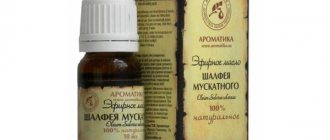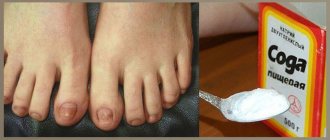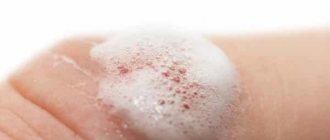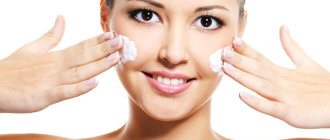What kind of woman wants to have beautiful slender legs? Just like any other part of the body, your feet need proper care. Unlike the old days, today any woman can find cosmetics that suit her. Manufacturers of creams, ointments, scrubs and other body care accessories seem to be competing with each other, coming up with more and more new products.
The pedicure procedure requires not only the use of these products, but also relaxing foot baths . The use of foot baths really helps relieve fatigue, get rid of unpleasant odors and eliminate rough keratinized growths. You don't have to go to the salon for this. Yes, there are no special devices at home, but in the past we somehow managed without them. Home procedures are much more profitable and no worse than those done by pedicurists. You just need to have the necessary things and know how to use the prepared baths correctly.
How to prepare baking soda foot baths
Feet need care and attention at any time of the year. You don’t always have time to go to professional pedicurists. Therefore, it is worth considering home care using baking soda.
A foot bath with soda will serve as an excellent solution to the problem of tired limbs. Baths with soda will cleanse oily skin and make its top layer porous, clearing it of excess layers. Soda can be found in any home. Even if you have to spend money and buy a pack of this product, the costs will be disproportionately low. In addition, you do not need a special amount of time to prepare soda baths.
Preparing such a bath is very simple.
1. Simple baking soda bath
- To do this, take two liters of warm water.
- Add 1 tablespoon of soda to the water and stir until completely dissolved.
- The resulting soda water is poured into a container where our feet will take their bath. By the way, you can do all this at once in the right basin so as not to overfill.
- Feet should be kept in water for 15-20 minutes. This time is enough for the feet to soften and the soda to have its effect.
- After the baths, you can begin your own pedicure procedure.
2. Baths with added soap
You can add soap along with baking soda to foot baths. In this case, the recipe will change slightly.
- For one liter of warm water you need one tablespoon of soda and one tablespoon of soap shavings. Ideally, it is better to take laundry soap, but since it may not suit everyone, any other will do.
- The solution must be whipped until foam appears. Your feet sink into this foam. Bath time is 15-20 minutes.
3. Bath of a mixture of salt and soda
- For preparation you need 2-3 liters of hot water. The water should be as hot as possible, but at the same time so that it can be tolerated.
- Dissolve one tablespoon of salt and soda in hot water. Both sea salt and table salt are suitable.
- By lowering your feet into the bath, you can enjoy the procedure for a quarter of an hour.
- At the end of the procedure, wipe the steamed legs with a towel and lubricate them with foot cream.
4. Essential oil and soda
- One tablespoon of soda dissolves in hot water.
- After this, pour 23–50 grams of olive oil into the water and add a few drops of any essential oil. Essential oil along with other components will have a relaxing effect. And thanks to hot water, the whole room will be filled with aroma. After such baths, your feet become soft and tender. It is olive oil that gives the same silkiness that we feel when using olive soap.
- During the procedures, you can add hot water to the basin. The bath time is the same as in other cases, 15–20 minutes.
The prerequisites for taking relaxing foot baths are that:
- The legs are kept in water up to the ankles.
- The water should be at least 40–50 degrees. As the water in the basin cools, boiling water is added to it.
- Contrast baths can be used for a general tonic effect for the whole body and for the legs. It is good for the skin and blood vessels. The legs are held alternately in cold and hot water. You need to hold your feet in one water and then in another the same number of times. The only difference is that when hot they last longer.
- Baths are best taken before bed, when the legs only need to rest. After water procedures, the feet are wiped dry and lubricated with your favorite nourishing creams.
Essential oils, sodium bicarbonate against nervous disorders, depression
The combination of NaHCO3, an aromatic ester, helps to cope with diseases of the nervous system. Normalization of an unstable emotional background is complemented by another positive quality - disinfection of the skin.
Regular procedures can eliminate inflammatory processes, speed up healing, and destroy harmful microbes.
Preparation:
- Heat water (2-3 l), it is not necessary to boil.
- Combine warm liquid, sodium bicarbonate (25 g), stir.
- Pour in the essential oil of chamomile, lavender, citrus, tea tree (5-8 ml).
The duration of the manipulations is 20 minutes. Exceeding the recommended time is prohibited - there is a risk of irritation of the dermis, the appearance of rashes, and disturbances in the water balance of the skin tissues.
Several reasons to take soda baths
The need for foot baths develops over time. If you did this before, and then quit or began to use baths less often due to lack of time , think about what your legs lost from this.
Reasons that could force a woman not to forget about the need for procedures may look like this:
- Soda baths are used to disinfect the feet. In this way, over time, you can get rid of corns or calluses that form as a result of wearing uncomfortable shoes and standing on your feet for a long time.
- Soda foot baths eliminate unpleasant odors, as soda fights harmful bacteria and helps get rid of them and fungal diseases. How does this happen? It's all about the acidic environment where bacteria can multiply. Water helps them with this. But soda already destroys acidity. No habitat - no bacteria. This only helps at the initial stage. Severe fungal infection can only be treated with medical methods.
- Uncomfortable shoes can lead to the formation of purulent inflammations under the nails. In this case, a hot bath with soda will help.
- Another good thing about baths with soda is that small cracks in the legs heal, burning and itching go away. Also, taking such baths helps soften the skin on the heels.
- In the morning you will not feel the same effect of baths as taking them in the evening. Exhausted feet will be doubly grateful if some essential oil is present in the water.
- An equally important reason for the procedures is women's health and beauty. Beautiful and healthy legs give health to the whole body and delight not only your eyes with beauty.
Getting more benefits will come from alternating different soda baths . It all depends on what effect someone needs.
Reviews from mothers
Ksenia A. My daughter is 5 years old. Her feet were steamed with juniper essential oil as soon as she was frozen. The child was delighted. Mom too. The cold is gone.
Marina S. My son often catches colds. On the advice of a friend, we did two foot baths after we were discharged from sick leave (I started coughing again). It became easier.
Lydia P. I’m floating on my feet, and my baby is nearby. Somehow it happened that he wanted to try it, but he started coughing. The next day I woke up healthy.
Traditional recipes with baking soda for coughs and colds.
How to treat sore feet with a baking soda bath
Of course, it is impossible to treat diseases, but you can get rid of some unpleasant moments and even prevent the development of the disease.
Baths with the addition of soda are a prevention of leg problems known to many , such as:
- Softening the skin of the feet, getting rid of calluses and cracks. These problems are treated by steaming the legs in a bath mixed with soda. After which the feet are smeared with a mixture of olive oil (50 g), apricot oil (2 g) and vitamin A (5 g). The procedure is repeated at least once a week.
- Frequent occurrence of cracks can be treated with daily baths. Plus, every other day, lubricate your heels with soap. After 5-10 minutes, the heels are wiped with pumice, the soap is washed off and the sore spots are lubricated with a rich cream.
- With heel spurs, the feet are steamed in a bath of soda. After steaming, apply a compress with kombucha to the sore spot and leave for 3-4 hours . After some time has elapsed, you can re-moisten the bandage with mushroom. This is how they are treated for a week to 10 days.
- Ingrown toenails are treated with warm baths. The steamed nail is trimmed straight and treated with iodine. Sometimes you can apply ointment and tie it overnight.
- Fungi on the fingers are best treated with cold water with salt and soda. Every day you need to keep your feet in the bath for 15-20 minutes, and then wash them with cold water.
- Nail fungus already needs hot water. The legs are steamed in it for half an hour for a month.
- Homemade balm after bathing helps tired feet. This balm should contain: olive oil (half a glass), a third of a glass of castor oil, and vitamin A in oil (10 g). All this is applied with massaging movements and warm socks are put on the legs.
Soaring children's feet
Photo: Depositphotos.com. Author: jhandersen.
During the procedure, the child should be more careful. The main indications for use are cough and runny nose.
Carefully! You should not soar your feet under the age of 5 years.
For children, use water at a lower temperature - no more than +37 °C. Typically, children do not really like hot water, so you should create more comfortable conditions for them so that they do not refuse the procedure.
On a note. More stringent restrictions also apply to the duration of warm foot baths in childhood - no more than 10 minutes.
Since children are more susceptible to medications, for them the concentration of soda and other components added to the water is halved.
After warming up, they try to put the child to bed, so the procedure is most often carried out before bed, or they simply put woolen socks on thoroughly dried feet and make sure that there is no draft in the room.
Contraindications for baths
Any procedure can both help and harm. What is useful for one is contraindicated for another. Therefore, when taking foot baths, be sure to take into account your doctor's advice .
- For example, this activity is strictly prohibited for patients with diabetes.
- Any type of tumor also does not accept baths.
- It is especially dangerous to steam your feet during infections, fever and colds.
- Hot baths are prohibited for people with heart disease, kidney disease, and varicose veins.
- Using baking soda too often can disrupt the pH, which can lead to dry feet and cracking.
All things should be beneficial. Therefore, not only should there be a certain regularity of water procedures , but also all individual characteristics should be taken into account.
Soap, sodium bicarbonate against fungal infection
The use of a soap-soda solution is recommended in the presence of rough skin, fungal diseases, and inflammatory processes. The number of manipulations is at least three per week.
Preparation:
- Grind the soap bar, use a grater or a sharp knife. To prepare the composition you will need 20 grams. crumbs.
- Combine baking soda (15 g.), soap powder.
- Pour the dry mixture with warm water (2.5 l).
- Stir until persistent soap foam appears.
If the composition is used for corns, calluses, fungal infections, after manipulations lasting a quarter of an hour, remove the affected tissue of the nail plates and keratinized particles of the dermis with pumice stone or scissors.
After steaming, eliminating tissues that cannot be restored, it is recommended to use a regenerating cream, an antifungal medicine. To increase the effectiveness of treatment, alternate home remedies based on baking soda - use soap, salt, and herbal compositions.
Main symptoms
It would not be superfluous to add that before removing corns, you need to make sure that the diagnosis is correct. So, the presented problem manifests itself as follows:
- in the initial stage, redness and swelling are observed affecting the affected area of the foot;
- as it develops, dry callus becomes much more noticeable, characterized by a grayish-yellow color and the absence of clear contours;
- the surface of the corn can be either smooth or rough, and may have cracks of varying depths;
- the sensitivity of the skin in areas affected by developing dry calluses is almost always reduced, and pain manifests itself while walking or running;
- provided there is an inflammatory process, most often provoked by infection, the discomfort increases significantly, and the size of the cracks increases noticeably.
Regarding the shape of dry calluses: it can be not only convex, but also flat. In addition, sometimes corns can cause the development of swelling of the soft tissues located in the immediate vicinity of them.
Corns can crack painfully
Why do they appear and what are they?
Corns and calluses are areas of rough, cracked skin that most often form on the feet and toes. The cause is insufficient blood supply, prolonged friction or pressure, usually caused by wearing tight and uncomfortable shoes, as well as lack of proper foot care. In this case, dead cells do not exfoliate, the epithelium thickens, and cracks appear.
Such rough areas are potential sources of inflammation, as the skin may begin to crack and bleed, and in severe cases inflammation may occur. This is why regular care is so important, and a bath is a good way to make the skin of your feet soft and tender.
https://youtube.com/watch?v=0iDYQKOKmwg
Precautionary measures
Like any other medicine, peroxide has restrictions on its use, which you must first familiarize yourself with. Otherwise, the treatment procedure may have the opposite effect and complicate the situation.
To prevent negative consequences, you should follow the following recommendations:
Before the first treatment, you need to do a sensitivity test. Baths and lotions are prohibited if you have an individual intolerance to the component. Treatment is contraindicated if the skin is excessively dry. If there are severe cracks or open wounds on the feet, then the procedure should be abandoned until complete healing. Sessions are carried out with special caution in severe forms of kidney and liver diseases, dermatitis herpetiformis.
Considering that you cannot constantly use this antiseptic, and you need to take care of the condition of your feet regularly, it is recommended to alternate the use of peroxide with solutions based on sea salt or infusions with the addition of coniferous herbs.
Among the medicinal plants that are effective are chamomile, calendula, nettle and St. John's wort.
Sodium bicarbonate, clay - a remedy for skin problems
Non-healing wounds, burns, infection, inflammatory processes are some of the problems that require immediate treatment. You can’t do without soda solutions that promote healing, destroy bacteria, and eliminate inflammation.
Recommended for you:
How to treat breast cancer with soda: recipes for solutions, therapeutic techniques of doctors
The most effective against such problems is considered to be a clay-based composition, NaHCO3.
Preparation:
- Knead blue clay (50 g) with your hands; it is recommended to purchase the substance at the pharmacy.
- Add baking soda (10 g) and stir.
- Heat water (1.5 l), pour in the mixture, stir until smooth.
Dip the lower limbs into the prepared product and leave for 20 minutes. Complete the procedure by rinsing with warm water; you can replace the liquid with a herbal decoction that has wound-healing, regenerating qualities.
Expert opinion
Advice!
To prepare a herbal decoction, use chamomile, calendula, string, and plantain. Pour 100 grams of boiling water over a liter. fresh plant materials. Cover the container with a lid and wrap it warmly with a towel to obtain a rich home remedy.
Rinse after cooling - hot liquid can cause irritation, burns, and unpleasant discomfort.
Why is baking soda effective for heel skin?
Regular baking soda or sodium bicarbonate is actively used by bakers and confectioners as a leavening agent. No carbonated drink is complete without this ingredient. It also helps to quickly remove grease and stains from kitchen utensils.
At the same time, the product has natural antiseptic, antifungal, softening and healing properties. This allows the use of sodium bicarbonate not only in the food industry, but also in cosmetology.
Thanks to its unique properties, soda can:
- clean rough heels;
- treat cracked heels;
- relieve swelling and fatigue of the legs;
- remove unpleasant odor.
However, 6tu4ka.ru reminds that sodium bicarbonate is an alkali, which means it can corrode, and therefore excessive abuse of this product is not recommended.











